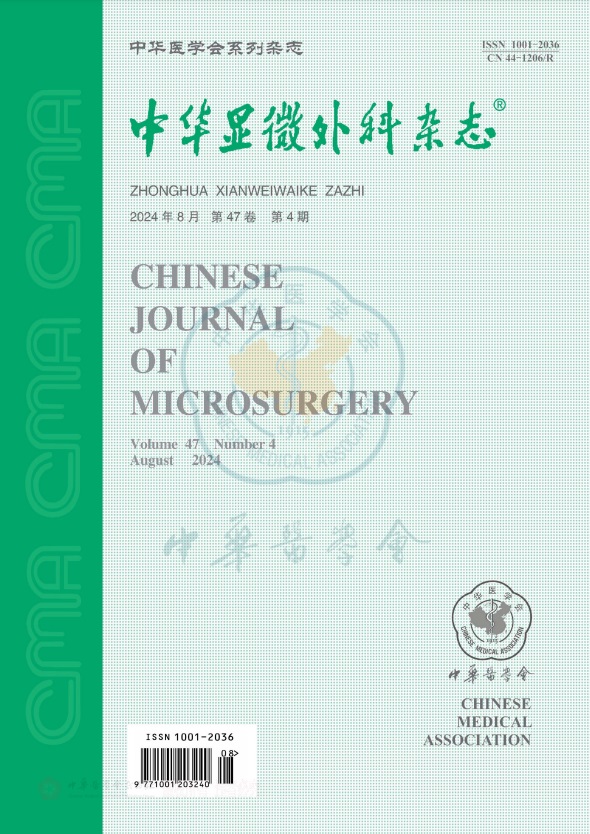锁眼入路神经导航辅助显微外科手术治疗颅内远端动脉瘤
引用次数: 0
摘要
目的探讨神经导航系统在颅内远端动脉瘤锁孔显微外科手术中的应用价值。方法回顾性分析2013年1月至2018年12月经锁孔入路治疗的16例DIAA患者的临床资料。10个动脉瘤位于大脑前动脉(ACA),3个位于小脑后下动脉(PICA)和3个位于穿支动脉(PA)。术前在神经导航系统的辅助下设计最佳的皮肤切口和开颅手术,在夹闭或切除前的显微外科手术中,在神经导航的指导下精确定位病变。出院前进行血管造影,每月进行临床随访,直至术后6个月。结果神经导航系统的系统误差为0.5~1.0mm,平均0.6mm。在神经导航系统指导下,16个动脉瘤均成功探查和治疗,无动脉瘤过早破裂和神经导航相关并发症。所有动脉瘤的绝对闭塞在术后的血管造影中均有记录。在所有病例中,2例因延迟性脑积水而经历分流手术。随访6个月,16例患者均恢复良好。结论神经导航系统能精确定位深部DIAA,有助于锁孔入路显微外科手术的术前规划,避免过度操作造成可以避免的损伤。无创、快速、增强的头部CT图像是神经导航系统的理想数据来源。关键词:颅内动脉瘤;手术方法;钥匙孔;神经导航;显微外科手术本文章由计算机程序翻译,如有差异,请以英文原文为准。
Neuronavigation-assisted microsurgical operation via keyhole approaches for distal intracranial artery aneurysms
Objective
To investigate the value of neuronavigation system in the keyhole microsurgical operation for distal intracranial artery aneurysms(DIAA).
Methods
The clinical data of 16 cases with DIAA who were treated by via keyhole approaches, from January, 2013 to December, 2018, were analyzed retrospectively. Ten aneurysms located in anterior cerebral artery(ACA), 3 in posterior inferior cerebellum artery(PICA) and 3 in perforator artery(PA). The optimal skin incision and craniotomy were designed with assistence of neuronavigation system preoperatively, and lesions were located precisely under the guidance of neuronavigation system during microsurgery before clipping or resection. Angiography was performed before discharge, and clinic followed-up was conducted monthly till 6 months after surgery.
Results
The systematic error of neuronavigation system ranged from 0.5 mm to 1.0 mm, with an average of 0.6 mm. All 16 aneurysms were explored and managed successfully with the guidance of neuronavigation system without aneurysm premature rupture nor neuronavigation-related complications. Absolute occlusion of all aneurysms was documented angiographically after surgery. Of all cases, 2 experienced shunt procedure due to delayed hydrocephalus. During 6 months follow-up period, all 16 cases recovered well.
Conclusion
Neuronavigation system can precisely locate the deep-seated DIAA, contribute to the preoperative planning of microsurgery via keyhole approaches and avoid evitable injury during excessive manipulation. The noninvasive, rapid and contrast-enhanced CT images of head was an ideal data source for the neuronavigation system.
Key words:
Intracranial aneurysm; Surgical approach; Keyhole; Neuronavigation; Microsurgical operation
求助全文
通过发布文献求助,成功后即可免费获取论文全文。
去求助
来源期刊
CiteScore
0.50
自引率
0.00%
发文量
6448
期刊介绍:
Chinese Journal of Microsurgery was established in 1978, the predecessor of which is Microsurgery. Chinese Journal of Microsurgery is now indexed by WPRIM, CNKI, Wanfang Data, CSCD, etc. The impact factor of the journal is 1.731 in 2017, ranking the third among all journal of comprehensive surgery.
The journal covers clinical and basic studies in field of microsurgery. Articles with clinical interest and implications will be given preference.

 求助内容:
求助内容: 应助结果提醒方式:
应助结果提醒方式:


